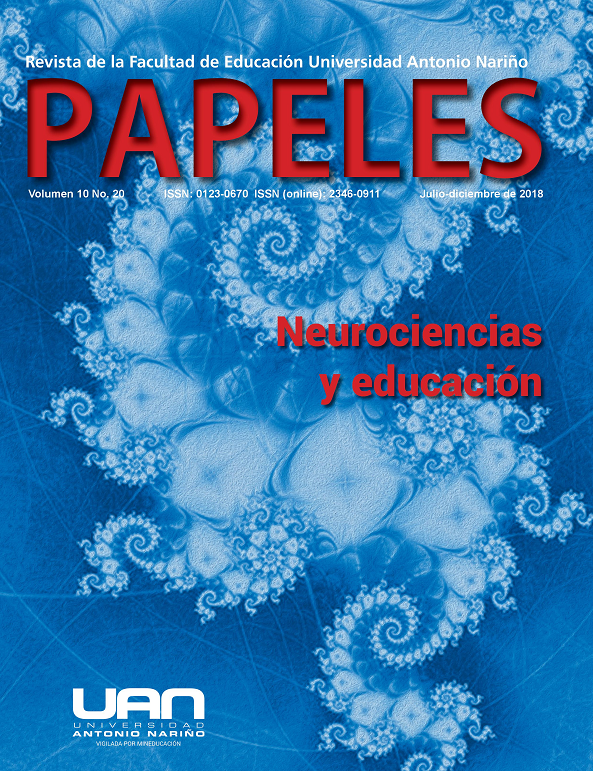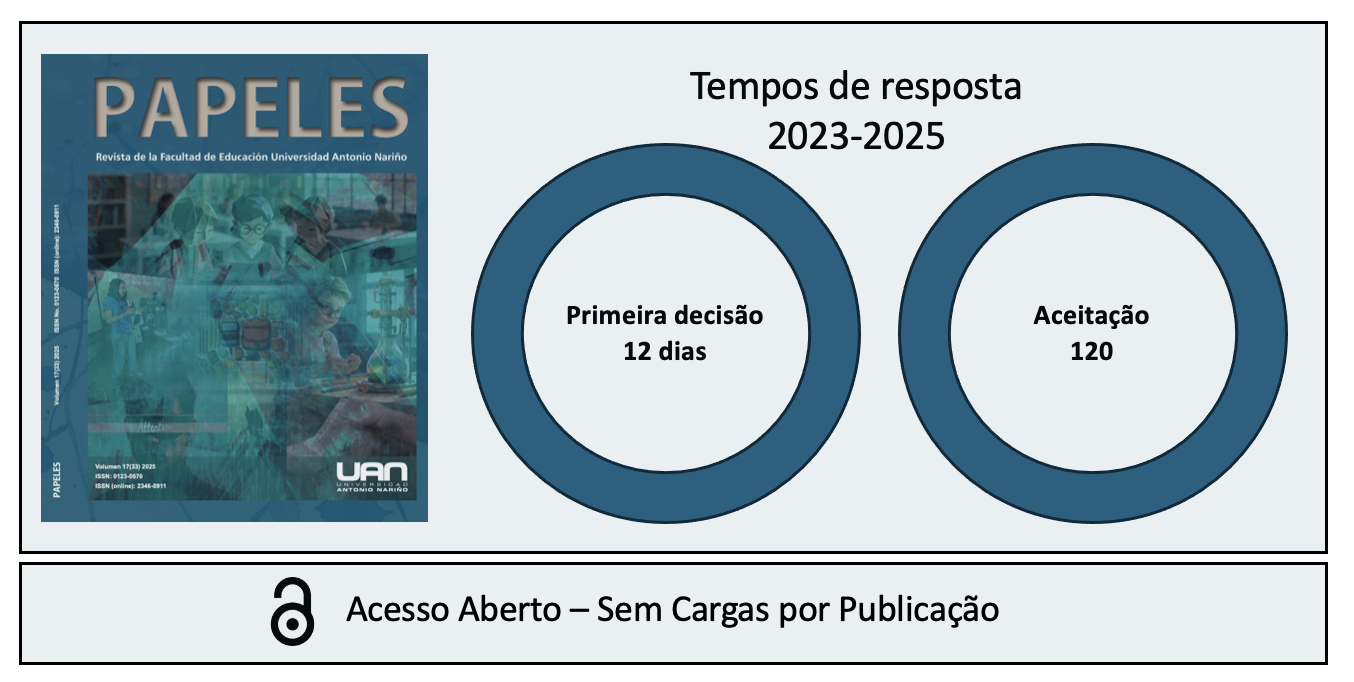Neurociencias y educación: brechas, desafíos y perspectivas
DOI:
https://doi.org/10.54104/papeles.v10n20.533Palavras-chave:
aprendizaje, cerebro, enseñanza, neurociencias, neuroeducación, plasticidad cerebralResumo
Las neurociencias han generado gran interés y entusiasmo en las últimas décadas en diversos campos del conocimiento. Uno de estos campos es la educación, razón por lo que se ideó el término neuroeducación. Sin embargo, existe una brecha entre las dos áreas, pues, aunque cada vez se acumula gran evidencia experimental acerca de las bases biológicas de las emociones, los procesos cognitivos y sus periodos críticos, son pocos los trabajos que muestran la extrapolación de esto en procesos educativos. Parte de esa brecha se debe a que los neurocientíficos tienen poca relación con la educación y los docentes no tienen una formación sólida en neurociencias. Esto, sumado al trabajo intuitivo por parte de expertos, en los procesos educativos, ha favorecido la creación de neuromitos, que generan confusión y alejan la posibilidad de una verdadera integración entre neurociencias y educación. Para reducir esta brecha se requieren capacitaciones permanentes a docentes en temas de neurociencias, capacitaciones de neurocientíficos en educación y mayor investigación y divulgación de resultados que validen o descarten la evidencia experimental. Los resultados de estas investigaciones serán clave para orientar políticas educativas que redunden en el mejoramiento de la calidad de la educación de futuras generaciones.
Downloads
Referências
(1) Alferink, L. A., & Farmer-Dougan, V. (2010). Brain-(not) Based Education: Dangers of Misunderstanding and Misapplication of Neuroscience Research. Exceptionality, 18(1), 42-52. https://doi.org/10.1080/09362830903462573
(2) Ansari, D., De Smedt, B., & Grabner, R. H. (2012). Neuroeducation – A Critical Overview of An Emerging Field. Neuroethics, 5(2), 105-117. https://doi.org/10.1007/s12152-011-9119-3
(3) Auerbach, J. G., Gross-Tsur, V., Manor, O., & Shalev, R. S. (2008). Emotional and Behavioral Characteristics Over a Six-Year Period in Youths With Persistent and Nonpersistent Dyscalculia. Journal of Learning Disabilities, 41(3), 263-273. https://doi.org/10.1177/0022219408315637
(4) Bain, P. G. (2019). Invited Article: Changing concepts in Parkinson disease: Moving beyond the Decade of the Brain. Recuperado de http://n.neurology.org/content/invited-article-changing-concepts-parkinson-disease-moving-beyond-decade-brain
(5) Barsom, E. Z., Graafland, M., & Schijven, M. P. (2016). Systematic review on the effectiveness of augmented reality applications in medical training. Surgical Endoscopy, 30(10), 4174-4183. https://doi.org/10.1007/s00464-016-4800-6
(6) Bassiony, M. M., & Lyketsos, C. G. (2003). Delusions and Hallucinations in Alzheimer’s Disease: Review of the Brain Decade. Psychosomatics, 44(5), 388-401. https://doi.org/10.1176/appi.psy.44.5.388
(7) Bialystok, E., Craik, F. I. M., & Luk, G. (2012). Bilingualism: consequences for mind and brain. Trends in Cognitive Sciences, 16(4), 240-250. https://doi.org/10.1016/j.tics.2012.03.001
(8) Boekaerts, M., de Koning, E., & Vedder, P. (2006). Goal-directed behavior and contextual factors in the classroom: An innovative approach to the study of multiple goals. Educational Psychologist, 41(1), 33-51. https://doi.org/10.1207/s15326985ep4101_5
(9) Bowers, J. S. (2016). The practical and principled problems with educational neuroscience. Psychological Review, 123(5), 600-612. https://doi.org/10.1037/rev0000025
(10) Bugden, S., DeWind, N. K., & Brannon, E. M. (2016). Using cognitive training studies to unravel the mechanisms by which the approximate number system supports symbolic math ability. Current Opinion in Behavioral Sciences, 10, 73-80. https://doi.org/10.1016/j.cobeha.2016.05.002
(11) Cardoso-Leite, P., & Bavelier, D. (2014). Video game play, attention, and learning: how to shape the development of attention and influence learning? Current Opinion in Neurology, 27(2), 185. https://doi.org/10.1097/WCO.0000000000000077
(12) Carter, S. P., Greenberg, K., & Walker, M. S. (2017). The impact of computer usage on academic performance: Evidence from a randomized trial at the United States Military Academy. Economics of Education Review, 56, 118-132. https://doi.org/10.1016/j.econedurev.2016.12.005
(13) Castañeda, L., & Selwyn, N. (2018). More than tools? Making sense of the ongoing digitizations of higher education. International Journal of Educational Technology in Higher Education, 15(1), 22. https://doi.org/10.1186/s41239-018-0109-y
(14) Cavalli-Sforza, L. L. (2005). The Human Genome Diversity Project: past, present and future. Nature Reviews Genetics, 6(4), 333-340. https://doi.org/10.1038/nrg1596
(15) Coeckelbergh, M. (2018). Technology and the good society: A polemical essay on social ontology, political principles, and responsibility for technology. Technology in Society, 52, 4-9. https://doi.org/10.1016/j.techsoc.2016.12.002
(16) Collins, F. S., Patrinos, A., Jordan, E., Chakravarti, A., Gesteland, R., Walters, L., & Groups, the members of the D. and N. planning. (1998). New Goals for the U.S. Human Genome Project: 1998-2003. Science, 282(5389), 682-689. https://doi.org/10.1126/science.282.5389.682
(17) Crone, E. A., & Dahl, R. E. (2012). Understanding adolescence as a period of social–affective engagement and goal flexibility. Nature Reviews Neuroscience, 13(9), 636-650. https://doi.org/10.1038/nrn3313
(18) Dehaene, S., Piazza, M., Pinel, P., & Cohen, L. (2003). Three Parietal Circuits for Number Processing. Cognitive Neuropsychology, 20(3-6), 487-506. https://doi.org/10.1080/02643290244000239
(19) Diamond, A., & Ling, D. S. (2016). Conclusions about interventions, programs, and approaches for improving executive functions that appear justified and those that, despite much hype, do not. Developmental Cognitive Neuroscience, 18, 34-48. https://doi.org/10.1016/j.dcn.2015.11.005
(20) Dror, I., Schmidt, P., & O’connor, L. (2011). A cognitive perspective on technology enhanced learning in medical training: Great opportunities, pitfalls and challenges. Medical Teacher, 33(4), 291-296. https://doi.org/10.3109/0142159X.2011.550970
(21) Eslinger, P. J., & Damasio, A. R. (1986). Preserved motor learning in Alzheimer’s disease: implications for anatomy and behavior. Journal of Neuroscience, 6(10), 3006-3009. https://doi.org/10.1523/JNEUROSCI.06-10-03006.1986
(22) Farah, M. J. (2018). Socioeconomic status and the brain: prospects for neuroscience-informed policy. Nature Reviews Neuroscience, 19(7), 428. https://doi.org/10.1038/s41583-018-0023-2
(23) Forlin, C. (2010). Teacher education reform for enhancing teachers’ preparedness for inclusion. International Journal of Inclusive Education, 14(7), 649-653. https://doi.org/10.1080/13603111003778353
(24) Fried, C. B. (2008). In-class laptop use and its effects on student learning. Computers y Education, 50(3), 906-914. https://doi.org/10.1016/j.compedu.2006.09.006
(25) Gago Galvagno, L. G., Elgier, Á. M., Gago Galvagno, L. G., & Elgier, Á. M. (2018). Building bridges between neuroscience and education. Neurosciences’ contributions, limitations and future directions in the education field. Psicogente, 21(40), 476-494. https://doi.org/10.17081/psico.21.40.3087
(26) Garbin, G., Sanjuan, A., Forn, C., Bustamante, J. C., Rodriguez-Pujadas, A., Belloch, V., … Ávila, C. (2010). Bridging language and attention: Brain basis of the impact of bilingualism on cognitive control. NeuroImage, 53(4), 1272-1278. https://doi.org/10.1016/j.neuroimage.2010.05.078
(27) Gardner, H. (1995). Reflections on Multiple Intelligences: Myths and Messages. Phi Delta Kappan, 77(3).
(28) Gleichgerrcht, E., Luttges, B. L., Salvarezza, F., & Campos, A. L. (2015). Educational Neuromyths Among Teachers in Latin America. Mind, Brain, and Education, 9(3), 170-178. https://doi.org/10.1111/mbe.12086
(29) Goldstein, M. (1993). Decade of the brain: National Institute of Neurological Disorders and Stroke. Neurosurgery, 32(2), 297.
(30) Goldstein, M. (1994). Decade of the brain. An agenda for the nineties. Western Journal of Medicine, 161(3), 239-241.
(31) Goswami, U. (2006). Neuroscience and education: from research to practice? Nature Reviews Neuroscience, 7(5), 406-413. https://doi.org/10.1038/nrn1907
(32) Guze, P. A. (2015). Using Technology to Meet the Challenges of Medical Education. Transactions of the American Clinical and Climatological Association, 126, 260-270.
(33) Hanley, L. (2013). Educational Technology and Restructuring Academic Labor. Workplace: A Journal for Academic Labor, 0(9). Recuperado de https://ices.library.ubc.ca/index.php/workplace/article/view/184044
(34) Hardiman, M., Rinne, L., Gregory, E., & Yarmolinskaya, J. (2012). Neuroethics, Neuroeducation, and Classroom Teaching: Where the Brain Sciences Meet Pedagogy. Neuroethics, 5(2), 135-143. https://doi.org/10.1007/s12152-011-9116-6
(35) Harris, J., Newcombe, N. S., & Hirsh‐Pasek, K. (2013). A New Twist on Studying the Development of Dynamic Spatial Transformations: Mental Paper Folding in Young Children. Mind, Brain, and Education, 7(1), 49-55. https://doi.org/10.1111/mbe.12007
(36) Hembrooke, H., & Gay, G. (2003). The laptop and the lecture: The effects of multitasking in learning environments. Journal of Computing in Higher Education, 15(1), 46-64. https://doi.org/10.1007/BF02940852
(37) Hook, C. J., & Farah, M. J. (2013). Neuroscience for Educators: What Are They Seeking, and What Are They Finding? Neuroethics, 6(2), 331-341. https://doi.org/10.1007/s12152-012-9159-3
(38) Hoorn, J. van, Dijk, E. van, Meuwese, R., Rieffe, C., & Crone, E. A. (2016). Peer Influence on Prosocial Behavior in Adolescence. Journal of Research on Adolescence, 26(1), 90-100. https://doi.org/10.1111/jora.12173
(39) Howard-Jones, P. A. (2014). Neuroscience and education: myths and messages. Nature Reviews Neuroscience, 15(12), 817-824. https://doi.org/10.1038/nrn3817
(40) Jiang, F., VanDyke, R. D., Zhang, J., Li, F., Gozal, D., & Shen, X. (2011). Effect of chronic sleep restriction on sleepiness and working memory in adolescents and young adults. Journal of Clinical and Experimental Neuropsychology, 33(8), 892-900. https://doi.org/10.1080/13803395.2011.570252
(41) Jones, E. G., & Mendell, L. M. (1999). Assessing the Decade of the Brain. Science, 284(5415), 739-739. https://doi.org/10.1126/science.284.5415.739
(42) Juma, S., Lehtomäki, E., & Naukkarinen, A. (2017). Scaffolding teachers to foster inclusive pedagogy and presence through collaborative action research. Educational Action Research, 25(5), 720-736. https://doi.org/10.1080/09650792.2016.1266957
(43) Kaufmann, L. (2008). Dyscalculia: neuroscience and education. Educational Research, 50(2), 163-175. https://doi.org/10.1080/00131880802082658
(44) Keehn, G., Anderson, M., & Boyles, D. (2018). Neoliberalism, Technology, and the University: Max Weber’s Concept of Rationalization as a Critique of Online Classes in Higher Education. En A. Stoller y E. Kramer (Eds.), Contemporary Philosophical Proposals for the University: Toward a Philosophy of Higher Education (pp. 47-66). Cham: Springer International Publishing. https://doi.org/10.1007/978-3-319-72128-6_3
(45) Knox, R. (2016). Mind, Brain, and Education: A Transdisciplinary Field. Mind, Brain, and Education, 10(1), 4-9. https://doi.org/10.1111/mbe.12102
(46) Knudsen, E. I. (2004). Sensitive periods in the development of the brain and behavior. Journal of Cognitive Neuroscience, 16(8), 1412-1425. https://doi.org/10.1162/0898929042304796
(47) Kroll, J. F., Dussias, P. E., Bice, K., & Perrotti, L. (2015). Bilingualism, Mind, and Brain. Annual Review of Linguistics, 1(1), 377-394. https://doi.org/10.1146/annurev-linguist-030514-124937
(48) Lance, C. (2018). Music and the Brain: How Music Affects the Work of the Brain. The Research and Scholarship Symposium. Recuperado de https://digitalcommons.cedarville.edu/research_scholarship_symposium/2018/podium_presentations/6
(49) Lang, P. J., Davis, M., & Öhman, A. (2000). Fear and anxiety: animal models and human cognitive psychophysiology. Journal of Affective Disorders, 61(3), 137-159. https://doi.org/10.1016/S0165-0327(00)00343-8
(50) Lo, J. C., Ong, J. L., Leong, R. L. F., Gooley, J. J., & Chee, M. W. L. (2016). Cognitive Performance, Sleepiness, and Mood in Partially Sleep Deprived Adolescents: The Need for Sleep Study. Sleep, 39(3), 687-698. https://doi.org/10.5665/sleep.5552
(51) Lovaas, O. I. (1987). Behavioral treatment and normal educational and intellectual functioning in young autistic children. Journal of Consulting and Clinical Psychology, 55(1), 3-9. https://doi.org/10.1037/0022-006X.55.1.3
(52) Maxwell, B., & Racine, E. (2012). The Ethics of Neuroeducation: Research, Practice and Policy. Neuroethics, 5(2), 101-103. https://doi.org/10.1007/s12152-012-9156-6
(53) Mayer, R. E. (2019). Computer Games in Education. Annual Review of Psychology, 70(1), null. https://doi.org/10.1146/annurev-psych-010418-102744
(54) Menon, V. (2016). Working memory in children’s math learning and its disruption in dyscalculia. Current Opinion in Behavioral Sciences, 10, 125-132. https://doi.org/10.1016/j.cobeha.2016.05.014
(55) Millei, Z., & Joronen, M. (2016). The (bio)politicization of neuroscience in Australian early years policies: fostering brain-resources as human capital. Journal of Education Policy, 31(4), 389-404. https://doi.org/10.1080/02680939.2016.1148780
(56) Neville, H. J., Stevens, C., Pakulak, E., Bell, T. A., Fanning, J., Klein, S., & Isbell, E. (2013). Family-based training program improves brain function, cognition, and behavior in lower socioeconomic status preschoolers. Proceedings of the National Academy of Sciences, 110(29), 12138-12143. https://doi.org/10.1073/pnas.1304437110
(57) Noël, M.-P. (2005). Finger gnosia: a predictor of numerical abilities in children? Child Neuropsychology, 11(5), 413-430. https://doi.org/10.1080/09297040590951550
(58) Ochsner, K. N., & Gross, J. J. (2005). The cognitive control of emotion. Trends in Cognitive Sciences, 9(5), 242-249. https://doi.org/10.1016/j.tics.2005.03.010
(59) Ochsner, K. N., Ray, R. D., Cooper, J. C., Robertson, E. R., Chopra, S., Gabrieli, J. D. E., & Gross, J. J. (2004). For better or for worse: neural systems supporting the cognitive down- and up-regulation of negative emotion. NeuroImage, 23(2), 483-499. https://doi.org/10.1016/j.neuroimage.2004.06.030
(60) Okuda, Y., Bryson, E. O., DeMaria, S., Jacobson, L., Quinones, J., Shen, B., & Levine, A. I. (2009). The Utility of Simulation in Medical Education: What Is the Evidence? Mount Sinai Journal of Medicine: A Journal of Translational and Personalized Medicine, 76(4), 330-343. https://doi.org/10.1002/msj.20127
(61) Palghat, K., Horvath, J. C., & Lodge, J. M. (2017). The hard problem of ‘educational neuroscience’. Trends in Neuroscience and Education, 6, 204-210. https://doi.org/10.1016/j.tine.2017.02.001
(62) Pasquinelli, E. (2012). Neuromyths: Why Do They Exist and Persist? Mind, Brain, and Education, 6(2), 89-96. https://doi.org/10.1111/j.1751-228X.2012.01141.x
(63) Patall, E. A., Cooper, H., & Allen, A. B. (2010). Extending the School Day or School Year: A Systematic Review of Research (1985–2009). Review of Educational Research, 80(3), 401-436. https://doi.org/10.3102/0034654310377086
(64) Pickering, S. J., & Howard‐Jones, P. (2007). Educators’ Views on the Role of Neuroscience in Education: Findings From a Study of UK and International Perspectives. Mind, Brain, and Education, 1(3), 109-113. https://doi.org/10.1111/j.1751-228X.2007.00011.x
(65) Piekarski, D. J., Boivin, J. R., & Wilbrecht, L. (2017). Ovarian Hormones Organize the Maturation of Inhibitory Neurotransmission in the Frontal Cortex at Puberty Onset in Female Mice. Current Biology, 27(12), 1735-1745.e3. https://doi.org/10.1016/j.cub.2017.05.027
(66) Piekarski, D. J., Johnson, C. M., Boivin, J. R., Thomas, A. W., Lin, W. C., Delevich, K., … Wilbrecht, L. (2017). Does puberty mark a transition in sensitive periods for plasticity in the associative neocortex? Brain Research, 1654, 123-144. https://doi.org/10.1016/j.brainres.2016.08.042
(67) Rice D, & Barone S. (2000). Critical periods of vulnerability for the developing nervous system: evidence from humans and animal models. Environmental Health Perspectives, 108(suppl 3), 511-533. https://doi.org/10.1289/ehp.00108s3511
(68) Ruiz-Ariza, A., Grao-Cruces, A., Loureiro, N. E. M. de, & Martínez-López, E. J. (2017). Influence of physical fitness on cognitive and academic performance in adolescents: A systematic review from 2005–2015. International Review of Sport and Exercise Psychology, 10(1), 108-133. https://doi.org/10.1080/1750984X.2016.1184699
(69) Sahakian, B. J., Morris, R. G., Evenden, J. L., Heald, A., Levy, R., Philpot, M., & Robbins, T. W. (1988). A COMPARATIVE STUDY OF VISUOSPATIAL MEMORY AND LEARNING IN ALZHEIMER-TYPE DEMENTIA AND PARKINSON’S DISEASE. Brain, 111(3), 695-718. https://doi.org/10.1093/brain/111.3.695
(70) Sana, F., Weston, T., & Cepeda, N. J. (2013). Laptop multitasking hinders classroom learning for both users and nearby peers. Computers y Education, 62, 24-31. https://doi.org/10.1016/j.compedu.2012.10.003
(71) Silver, H., Strong, R., & Perini, M. (1997). Integrating Learning Styles and Multiple Intelligences. Educational Leadership, 55(1), 22-27.
(72) Simpson, G. V., Pflieger, M. E., Foxe, J. J., Ahlfors, S. P., Vaughan, J. H., Hrabe, J., … Lantos, G. (1995). Dynamic neuroimaging of brain function. Journal of Clinical Neurophysiology : Official Publication of the American Electroencephalographic Society, 12(5), 432-449.
(73) Spreen, O. (1989). The relationship between learning disability, emotional disorders, and neuropsychology; some results and observations. Journal of Clinical and Experimental Neuropsychology, 11(1), 117-140. https://doi.org/10.1080/01688638908400880
(74) Stein, Z. (2010). On the Difference Between Designing Children and Raising Them: Ethics and the Use of Educationally Oriented Biotechnology. Mind, Brain, and Education, 4(2), 53-67. https://doi.org/10.1111/j.1751-228X.2010.01085.x
(75) Stein, Z., Chiesa, B. D., Hinton, C., & Fischer, K. W. (2011). Ethical issues in Educational Neuroscience: Raising children in a Brave New World. Oxford Handbook of Neuroethics. https://doi.org/10.1093/oxfordhb/9780199570706.013.0179
(76) Sylvan, L. J., & Christodoulou, J. A. (2010). Understanding the Role of Neuroscience in Brain Based Products: A Guide for Educators and Consumers. Mind, Brain, and Education, 4(1), 1-7. https://doi.org/10.1111/j.1751-228X.2009.01077.x
(77) Tardif, E., Doudin, P.-A., & Meylan, N. (2015). Neuromyths Among Teachers and Student Teachers. Mind, Brain, and Education, 9(1), 50-59. https://doi.org/10.1111/mbe.12070
(78) Thomas, M. S. C., Ansari, D., & Knowland, V. C. P. (2018). Annual Research Review: Educational neuroscience: progress and prospects. Journal of Child Psychology and Psychiatry, and Allied Disciplines. https://doi.org/10.1111/jcpp.12973
(79) Yurgelun-Todd, D. (2007). Emotional and cognitive changes during adolescence. Current Opinion in Neurobiology, 17(2), 251-257. https://doi.org/10.1016/j.conb.2007.03.009
(80) Zaharia, S. (2002). A Comparative Overview of Some Fundamental Aspects of University Management as Practiced in Several European Countries. Higher Education in Europe, 27(3), 301-311. https://doi.org/10.1080/0379772022000015032
(81) Zhu, E., Hadadgar, A., Masiello, I., & Zary, N. (2014). Augmented reality in healthcare education: an integrative review. PeerJ, 2, e469. https://doi.org/10.7717/peerj.469
(82) Zocchi, M., & Pollack, C. (2013). Educational Neuroethics: A Contribution From Empirical Research. Mind, Brain, and Education, 7(1), 56-62. https://doi.org/10.1111/mbe.12008
(83) Zugman, A., Sato, J. R., Jackowski, A. P., Zugman, A., Sato, J. R., & Jackowski, A. P. (2016). Crisis in neuroimaging: is neuroimaging failing 15 years after the decade of the brain? Brazilian Journal of Psychiatry, 38(4), 267-269. https://doi.org/10.1590/1516-4446-2016-2071
Downloads
Publicado
-
Resumo1230
-
PDF (Español)1314
Como Citar
Edição
Seção
Licença

Este trabalho está licenciado sob uma licença Creative Commons Attribution-NonCommercial-ShareAlike 4.0 International License.





